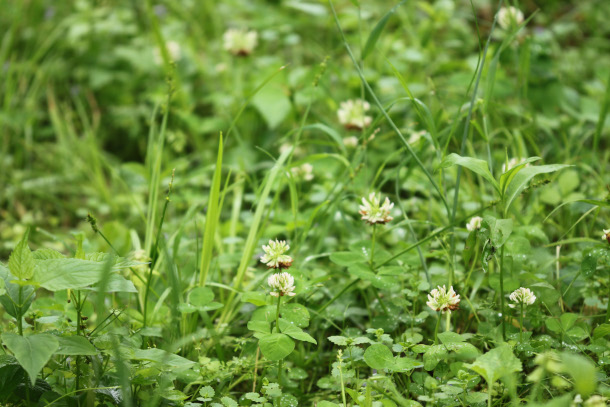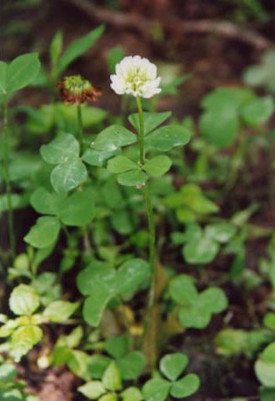Running Buffalo Clover
Air Date: Week of June 11, 2021

The plants with the white flowers are the endangered running buffalo clover (Trifolium stoloniferum), among various other plants. (Photo: USFWS, Flickr, Public Domain)
For nearly half a century, Americans believed the running buffalo species of clover to be extinct, until a biologist discovered the plant on a hike 30 years ago. Glynis Board from the Ohio Valley ReSource reports from West Virginia on efforts to try and encourage the growth of the endangered species.
Transcript
CURWOOD: There are more than 50 different species of clover in the US. Glynis Board from the Ohio Valley ReSource has this story about a rare clover once thought to be extinct.
BOARD: It's a plant we all know and love, or we think we do. The clover. But one species of clover was thought to be extinct until someone found it in West Virginia 30 years ago. Biologist Rodney Bartgis recalls his discovery was met with some skepticism.
BARTGIS: We were walking along the trail and I told Clois, hey there's running buffalo clover. And he said, no, it's extinct. I said Clois, that's it and he bet me a steak dinner that that was not running buffalo clover. And I got that steak dinner. So that's how it was rediscovered.
BOARD: After Bartgis reported the find, running buffalo clover was moved on to the endangered species list. Today he's hiking with Melissa Thomas-Van Gundy, a research forester with the Forest Service stationed here at the Fernow Experimental Forest in West Virginia. That's one place where you can find the clover.
THOMAS- VANGUNDY: Part of the running part comes from these stolons. These plant parts that are like a strawberry runner.
BOARD: For years, Thomas-VanGundy has been helping to manage the populations of running buffalo clover found here.

Running buffalo clover (Photo: Sarena Selbo, USFWS, Wikimedia Commons, Public Domain)
THOMAS- VANGUNDY: Of course, it's not blooming right now, but that is a really good way to identify it.
BOARD: These clover are not like the ones you find in your yard. They're much more sensitive. They can't tolerate full sun, full shade or severe disturbance. That said Thomas- VanGundy explains they love heavy machinery. She explains that in this particular tract of land, forest managers use heavy machinery every 10 years or so on paths they call skid roads.
THOMAS-VANGUNDY: When we first found this. I think it was along this trail somewhere. We say okay; well Fish and Wildlife Services says, you guys can't disturb those plants, put your skid road up there. Don't use this skid road. Okay, we did that. Came back in, plant numbers had dropped where we hadn't run over them. It showed up on the new skid road. So it's kind of a frustrating plant. If you think you have to stay off of it.
BOARD: The US Fish and Wildlife Service listed the clover as endangered in 1987. Since then, more populations have been found and monitored. Today about 150 populations are known to exist in six states. Many of these populations are on public lands or they're on private land with conservation agreements. Thomas Van Gundy and Bartgis say protecting these rare plants is an important part of maintaining the protective benefits of biodiversity. They say a more diverse forest is more resilient to disease, pointing out that humans ultimately depend on healthy ecosystems for clean air and water. But Bartgis says his motivation to protect the running buffalo clover is also rooted in the value of the stories it tells.
BARTGIS: Just imagine standing right here and a herd of mastodon comes through. We know that that happened fairly routinely. That's what this, that's the disturbance making that most of the species evolved in. So you know, once the mastodons and things like that died out, they relied upon, you know the Buffalo and elk so we can go back to that story. And now they rely on us.
BOARD: When asked if he thought delisting the clover was a good idea Bartgis said he felt all right about it. But the running buffalo clover isn't quite out of the woods, so to speak. Bartgis pointed to stilt grass and other invasives that could displace more delicate native species. So it's important he adds to continue to keep an eye and maybe a reintroduced elk hoof on them. I'm Glynis Board in the Fernow Experimental Forest in West Virginia.
CURWOOD: Glynis Board’s story comes to us courtesy of the Ohio Valley ReSource.
Links
This story from The Allegheny Front via Ohio Valley ReSource
Living on Earth wants to hear from you!
Living on Earth
62 Calef Highway, Suite 212
Lee, NH 03861
Telephone: 617-287-4121
E-mail: comments@loe.org
Newsletter [Click here]
Donate to Living on Earth!
Living on Earth is an independent media program and relies entirely on contributions from listeners and institutions supporting public service. Please donate now to preserve an independent environmental voice.
NewsletterLiving on Earth offers a weekly delivery of the show's rundown to your mailbox. Sign up for our newsletter today!
 Sailors For The Sea: Be the change you want to sea.
Sailors For The Sea: Be the change you want to sea.
 The Grantham Foundation for the Protection of the Environment: Committed to protecting and improving the health of the global environment.
The Grantham Foundation for the Protection of the Environment: Committed to protecting and improving the health of the global environment.
 Contribute to Living on Earth and receive, as our gift to you, an archival print of one of Mark Seth Lender's extraordinary wildlife photographs. Follow the link to see Mark's current collection of photographs.
Contribute to Living on Earth and receive, as our gift to you, an archival print of one of Mark Seth Lender's extraordinary wildlife photographs. Follow the link to see Mark's current collection of photographs.
 Buy a signed copy of Mark Seth Lender's book Smeagull the Seagull & support Living on Earth
Buy a signed copy of Mark Seth Lender's book Smeagull the Seagull & support Living on Earth

